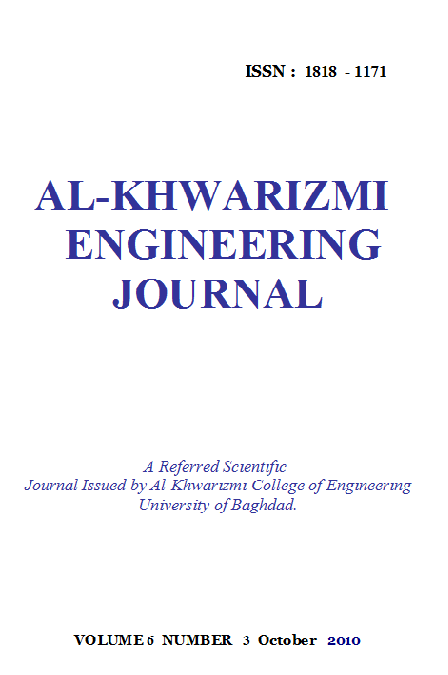The Effect of Surface Roughness on Thermohydrodynamic Performance in Misaligned Journal Bearings
Abstract
In this work an approach has been developed to investigate the influence of surface roughness on thermohydrodynamic performance in aligned and misaligned journal bearings by considering an average flow model and deriving the shear flow factor for various roughness configurations, similar to the pressure flow factor. An average Reynolds equation for rough surfaces is defined in term of pressure and shear flow factors, which can be obtained by numerical flow simulation, though the use of measured or numerically generated rough surfaces. Reynolds, heat conduction and energy equations are solved simultaneously by using a suitable numerical technique (Finite Difference Method) to obtain the pressure and temperature distribution through the oil film thickness of the journal bearing. These equations are obtained for isotropic surfaces and for surfaces with directional patterns. The flow factors for these surfaces are expressed as empirical relations in term of normalized oil film thickness (h/σ) and surface characteristic (γ) defined as the ratio of x and z correlation lengths . The results of this approach showed increase in load carrying capacity and maximum pressure and decrease in maximum temperature in the case of stationary surface roughness (rough bearing and smooth journal) with transverse pattern. The results obtained through this work have been compared with that published by other works and found to be in a good agreement.
Downloads
References
[2] J. Ferron, J. Frene and R. Boncompain, 1983, "A Study of the Thermohdrodynamic Performance of a plain Journal Bearing Comparison Between Theory and Experimental", ASME J. Lubr. Technol., Vol. 105, PP. 422 – 428.
[3] Junichi Mitsui, Yukio Hori and Masato Tanaka, 1986, "An Experimental Investigation on the Temperature Distribution in Circular Journal Bearings", ASME J. Tribol., Vol. 108, PP. 621 – 626.
[4] Jun'ichi Mitsui, 1987, "A Study of Thermo hydrodynamic Lubrication in a Circular Journal Bearing", Tribol. International, Vol. 11, PP. 331 – 341.
[5] H. H. OH and G. Paradissiadis, 1988, "Them hydrodynamic Analysis of Journal Bearings Considering Cavitation and Reverse Flow", ASME J. Tribol., Vol. 110, PP. 439 – 447.
[6] Oscar Pinkus and S. S. Bupara, 1978, "Analysis of Misaligned Grooved Journal Bearings", ASME J. Lubr. Technol., Vol. 101, PP. 503 – 508.
[7] Z. S. Safar, 1984, "Energy Loss due to Misalignment of Journal Bearings", Tribol. International, Vol. 03, PP. 107 – 110.
[8] R. H. Buckholz and J. F. Lin, 1986, "The Effect of Journal Bearing Misalignment on Load and Cavitation for non-Newtonian Lubricants", ASME J. Tribol., Vol. 108, PP. 645 – 653.
[9] Jiin-Yuh Jang and Chong- Ching Chang, 1987, "Adiabatic Solutions for A misaligned Journal Bearing with non-Newtonian Lubricants", Tribol. International, Vol. 09, PP. 267 – 275.
[10] Nadir Patir and H. S. Cheng, 1978, "An Average Flow Model for Determining Effects of Three-Dimensional Roughness on Partial Hydrodynamic Lubrication", ASME J. Lubr. Technol., Vol. 100, PP. 12 – 17.
[11] Nadir Patir and H. S. Cheng, 1979, "Application of Average Flow Model to Lubrication Between Rough Sliding Surfaces" ASME J. Lubr. Technol., Vol. 101, PP. 220 – 230.
[12] Chao Zhang and H. S. Cheng, 2000, "Transient Non-Newtonian Thermohydro-dynamic Mixed Lubrication of Dynamically Loaded Journal Bearings", Trans. ASME, Vol. 122, PP. 156 – 161.
[13] T. Nagaraju , Satish C. Sharma and S. C. Jain, 2007, "Influence of Surface Roughness on Non-Newtonian Thermohydrostatic Performance of a Hole-Entry Hybrid Journal Bearing" ASME J. Tribol., Vol. 129, PP. 595 – 602.
[14] J. H. Kim, S. K. Kim and J.-H. Kim, 2004, "The Influence of Surface Roughness on Thermohydrodynamic Analysis", Kookmin University
[15] Fanghui Shi and Qian (Jane) Wang, 1998, "A Mixed – TEHD Model for Journal – Bearing Conformal Contacts – Part I: Model Formulation and Approximation of Heat Transfer Considering Asperity Contact", ASME J. Tribol., Vol. 120, PP. 198 – 205.
[16] J. Ramesh, B.C. Majumdar and N.S.Rao, 1997, "Thermohydrodynamic analysis of submerged oil journal bearings considering surface roughness effects", Transactions of the ASME, Vol.119, January, PP. 100-106.
[17] J. Bouyer and M. Fillon, 2003, "Improvement of the THD performance of a misaligned plain journal is bearing", Transactions of the ASME, Vol.125, PP.334-342.
[18] Joon Hyun Kim and Joo-Hyun Kim, 2005, "Thermohydrodynamic analysis of surface roughness in the flow field", Journal of Tribology, Vol. 127, PP. 293-301.
[19] Ron A.J. van Ostayen and Anton Van Beek, 2009, "Thermal modeling of the lemon-bore hydrodynamic bearing", Tribology International , Vol 42,PP.23-32.
[20] Yansong Wang, Chao Zhang, Q. Jane Wang and Chih Lin, 2002, "Amixed – TEHD Analysis and Experiment of Journal Bearing under Severe Operating Conditions", Tribol. International, Vol. 35, PP. 395 – 407.
Downloads
Published
Issue
Section
License
Copyright: Open Access authors retain the copyrights of their papers, and all open access articles are distributed under the terms of the Creative Commons Attribution License, which permits unrestricted use, distribution, and reproduction in any medium, provided that the original work is properly cited. The use of general descriptive names, trade names, trademarks, and so forth in this publication, even if not specifically identified, does not imply that these names are not protected by the relevant laws and regulations. While the advice and information in this journal are believed to be true and accurate on the date of its going to press, neither the authors, the editors, nor the publisher can accept any legal responsibility for any errors or omissions that may be made. The publisher makes no warranty, express or implied, with respect to the material contained herein.












